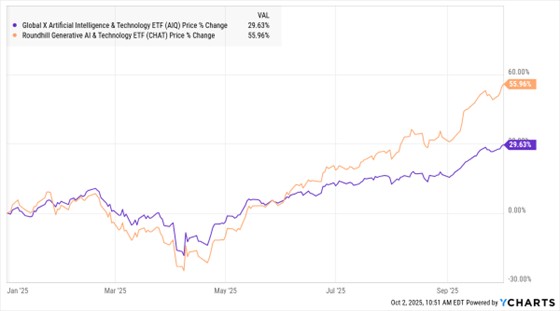AIQ And CHAT: Are These ETFs Vulnerable Amid AI Bubble Talk?
Image Source: Unsplash
Nvidia Corp. (NVDA) and OpenAI recently announced a “strategic partnership” under which the former will invest as much as $100 billion in the latter. But some critics are warning about a potential AI bubble. Here’s what to consider when it comes to funds like the Global X Artificial Intelligence & Technology ETF (AIQ) and Roundhill Generative AI & Technology ETF (CHAT), says Neena Mishra, director of ETF research at Zacks Investment Research.
The Nvidia investment will support new data centers with a capacity of at least 10 gigawatts of power. According to the Financial Times, the computing capacity could cost nearly $600 billion, with about $350 billion potentially going to Nvidia for its advanced chips used to train and deploy AI models.
Shares of Nvidia rose nearly 4% after the report. The company is the largest in the world, with a market capitalization over $4.5 trillion. Demand for its cutting-edge AI chips shows no signs of slowing. OpenAI, valued at close to $500 billion, is the most valuable privately held company. While its ChatGPT boasts more than 700 million monthly users, its path to profitability remains unclear.
AIQ, CHAT ETFs (Year-to-Date Percentage Change)

Data by YCharts
Some analysts raised concerns about the circular structure of the agreement, comparing it to vendor-financing subsidies seen during the dot-com bubble. Critics have also warned about a potential AI bubble, suggesting these large investments are designed to boost demand for Nvidia’s chips.
Unlike the dot-com bubble, however, the leading players in the race to artificial general intelligence today are highly profitable, cash-rich, mega-cap companies investing hundreds of billions to stay ahead. For them, the greater risk lies in underinvesting and losing the race, not in overspending.
Artificial general intelligence could transform our lives and result in enormous productivity gains. Further, valuations are not as extreme as during the dot-com bubble.
These big investments will likely result in handsome returns for some companies, while others may lose money. Some companies are already showing the positive impact of AI on their businesses. That’s why diversified exposure to AI beneficiaries via ETFs makes a lot of sense.
About the Author
Neena Mishra, CFA, FRM, is the director of ETF research for Zacks Investment Research. Prior to that, she spent approximately 15 years with the Reserve Bank of India, the Indian equivalent of the Federal Reserve Board, where she supervised the financial sector and managed the country's foreign exchange reserves.
Ms. Mishra is frequently sought after by the media for her insights on ETF-related topics. Her expert commentary on ETFs has appeared in major financial media outlets, including The Wall Street Journal, Financial Times, CNBC.com, Barron's, and MarketWatch. She holds an MS in Physics from Lucknow University, India, and an MBA in Finance from the University of Georgia.
More By This Author:
AUR: Driving Innovation In The Driverless Trucking Business
COST And KMX: Two Consumer Stocks On Divergent Paths
PYPL: Google Deal Shows CEO Is Delivering On His Promises




